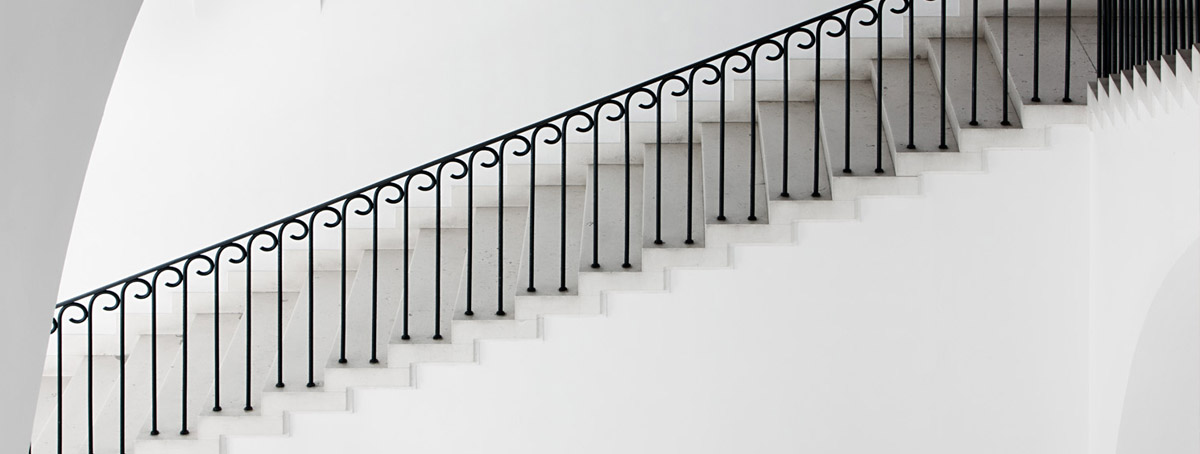ARCHIVE · 2022
ĐURO PULITIKA
(1922. – 2006.)
A RETROSPEKTIVE EXHIBITION
AUTHORS OF THE EXHIBITION: Zdenko Tonković, Rozana Vojvoda
EXPERT ASSOCIATE AT THE EXHIBITION: Maja Nodari
CURATOR OF THE EXHIBITION: Rozana Vojvoda
AUTHOR AND CURATOR OF THE DRAWING UNIT: Jelena Tamindžija Donnart
LAYOUT OF THE EXHIBITION: Zdenko Tonković, Rozana Vojvoda
LAYOUT OF THE DRAWING UNIT: Jelena Tamindžija Donnart
15.12.2022. - 5.3.2023.
The exhibition was organized on the occasion of the centenary of the birth of the great Dubrovnik painter Đuro Pulitika.

Spring Landscape, 1974, oil on canvas
Inevitably inscribed in a drawing is time, which we register in the rapid strokes, in the unfinished parts of the composition, in the limned and erased segments of the scene shown or perhaps when it is especially devoted to the minute elaboration of details. It needs no very long period of reflection, for its essence is accomplished in immediacy, through direct transfer of thought to paper without further ado. It is an area of a plethora of experiments and unbounded freedom of imagination which like a stream of consciousness novel flows over onto empty pages. For these very reasons, then, all the attributes according to which we can identify the style of Đuro Pulitika are here heightened, for in drawings and sketches the artist completely lays bare his thinking, depicting its chronological development in the thinking through of a given scene that will later be transferred to canvas. The demanding oil-on-canvas technique calls for calm on the part of the artist, attentiveness in his work, meticulousness, rationality and perspicacity, like measured and well- considered thoughts and sentences declaimed in an after-dinner speech. The drawings, then, were able to convey and condense the feeling of the long and relaxed evenings in an amicable and familial atmosphere to which the artist, as good host, was particularly inclined. During such nights he would be known to utter the whole diapason of an individual lexis, including anecdotes, non-standard words, laughter, quarrels, clinking of glasses, unpredicted and spontaneous moments that in the same manner and without any great censorship made their way into Pulitika’s drawing. - Zdenko Tonković

Nets, 1966, oil on canvas
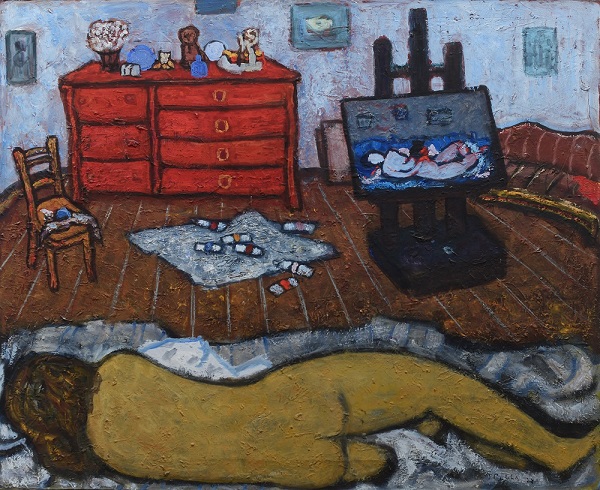
Reclining Nude in Interior, 1978, oil on canvas
HE’S NOT TO BLAME, HE’S A PAINTER!
documentary exhibition
Studio Pulitika, December 8th, 2022 – March 5th, 2023
Curator: Marijeta Radić

The documentary exhibition “He’s not to blame, he’s a painter!” shows for the first time a selection from the rich and meticulously assembled documentary material about the life and work of the painter Đuro Pulitika (1922-2006) on the occasion marking his 100th birth anniversary. The person we have to thank for being able to reconstruct down to the tiniest details the life and work of the retiring painter from Bosanka is his wife Mira Pulitika née Simunić, who deftly put her secretarial skills to work in private life, recording the path of development of Pulitika’s painting. The rich and diverse documentary material comprises numerous exhibition catalogues, particular importance attaching to those from the earliest phases and those from distant venues such as England, Switzerland, Belgium and the US; then there are invitations, newspaper notices and reviews written by art critics and art historians of the calibre of Antun Karaman, Sonja Seferović, Tomislav Lalin, Duško Kečkemet and Josip Depolo; numerous black and white documentary photographs taken through the lenses of well-regarded Croatian photographers like Krešimir Tadić, Nenad Gattin, Aleksandar Saša Novković and Šimo Dragičević. Particularly deserving of our notice of the posters are those from the Schira Gallery in Zagreb of 1979 and 1984, the poster of a big retrospective show in the Museum of Modern Art in Dubrovnik in 1982, of the exhibition in the Gallery of Fine Arts in Split as well as the numerous letters and greetings cards. Information about his 46 solo (since 1953) and almost 200 collective exhibitions in major museum institutions and gallery venues, both in Croatia and abroad is recorded. All these details have been preserved in an orderly manner, arranged in boxes, ring files, envelopes and albums, the contents of any given group of subjects clearly and precisely indicated (often picked out in red) as shown in this exhibition.

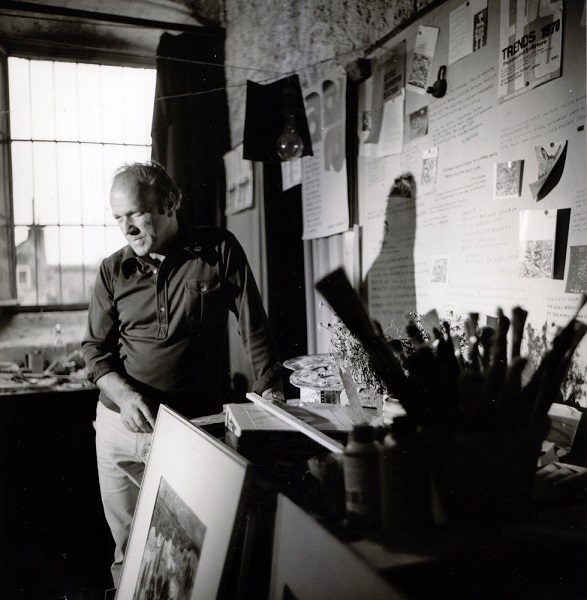

MARO MITROVIĆ
NEUTRAL BUOYANCY
A Retrospective Exhibition
27. 10. – 9. 12. 2022.
AUTHOR OF THE EXHIBITION: Jelena Tamindžija Donnart

Astrid, acrylic on canvas, 100 x 200 cm, 2007

Fortunately for people, it is falling apart, acrylic on canvas, 2017
Roberto Calasso in his book Tiepolo Pink refers to Tiepolo’s oeuvre as a “biographer’s nightmare”. And something similar could be said for the work of Maro Mitrović, not so much in the sense of the location of the pieces, as was the case with Tiepolo, for the whereabouts of most of Mitrović’s works have, with research, been discovered, but in the challenge of the propensity of the artist for diverse and eclectic artistic idioms. At the first look at his retrospective exhibition of paintings it might easily seem to someone that they are visiting a collective show, instead of a presentation of a single author’s one-man. The eclecticism to which Mitrović is inclined reveals an intellectual of an artist who thinks through his procedures, one who does not hesitate to travel to the land of experimentation and then go back again to his own native land. The never- ceasing journeys into new visual spheres results in a heterogeneity in his creative oeuvre that has often set sail for the study of different media of expression, such as photography, digital graphics, video, audio recordings, performance, poetry and TV broadcasts. In actual painting Mitrović selects the usual but also unconventional techniques of painting, and he will most often opt for the use of acrylics and acrylic markers, but will also go in for collage, transparent glass paint and Oikos multifund paint for house painting.

Low albedo in Šuma Striborova, acrylic on canvas, 2017
Biography:
Maro (Marojica) Mitrović was born 1950 in Dubrovnik. This is where he graduated from his pedagogic gymnasium, whereas he graduated from Accademia di Belle Arti di Brera in Milan in 1972. His work was first exhibited at the 8th October Exhibition in 1971 at the Museum of Modern Art Dubrovnik while he was still a student, and his first solo exhibition took place at Sebastian Gallery in Dubrovnik in 1975. Even though painting has always been part of his life, Mitrović also took a shot at other creative media outlets. He was one of the founders of the Art Workshop Lazareti and its president in the late 1980s, and he exhibited his work in collaborative art projects. In 1984 he took a 12-year-long break from painting. He lived in the US from 1985 to 1988 and studied new photography techniques, the use of electronics in art, and electronic music. He is one of the first Croatian artists who embraced the segment of computerization and the debate on social media in art by presenting the exhibition “Facebook” at the Sebastian Gallery in Dubrovnik in 2009. Music has always been part of his artwork and he was one of the founders of many local music bands: Tomazopani in which he played the bass guitar from 1964 to 1966, Libertas from 1967 to 1970, Dubrovački poklisari from 1972 to 1975, and Tikwoony in which he was in charge of the percussions from 1991 to 1993. Mitrović often points out that he does not see himself as an active author of his work, but rather its tool, a medium that directs the creative energy. He lives and works in Dubrovnik. Maro Mitrović held solo exhibitions and participated in many group exhibitions.
VLAHO BUKOVAC
a recapitulation
from the MOMAD collection
7. 9. – 23. 10. 2022.
Author of the exhibition: Rozana Vojvoda
, 1897., ulje na platnu.jpg)
Allegory of Art IV (sculpture), 1897, oil on canvas
At the centenary of the death of Vlaho Bukovac, the conclusion inevitably to be drawn is that in the twenty-first century his work is more vital than ever. Vlaho Bukovac is constantly written about, top-flight Croatian museums put on big monographic and retrospective exhibitions, and there is lively competition among private collectors and public institutions whenever works come onto the market. Bukovac long ago won the title of “the founder of Croatian modern Art”, while Dubrovnik Museum of Modern Art, which is dedicated to the collection, exhibition and study of the works of modern and contemporary art simply describes the span of its interests as being “from the appearance of Vlaho Bukovac to the art of the present day”. Prompted by the centenary of the painter’s death, in this show the Dubrovnik Museum of Modern Art is undertaking as it were a recapitulation of its own collection, this text and the set-up underlining the tried and tested chronological division of the work of Bukovac into the Paris, Zagreb, Cavtat and Prague periods. But we are not concerned here with a comprehensive analysis of all the works of the great artist that came into the collection of the Museum through purchases from private owners and various donations, rather of the contextualisation of the material in the light of new understandings and knowledge of the history of art that came after the brilliant monograph on the life and work of Bukovac by Vera Kružić Uchytil, without which no serious exploration of the work of the great master can possibly begin. - Rozana Vojvoda
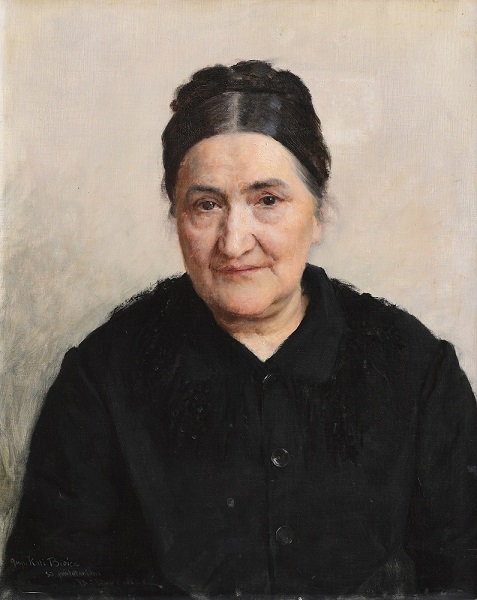
Portrait of Katarina Bibica, 1891, oil on canvas

Stromovka I., 1921, oil on cardboard
NIKO ANČIĆ
Color Happening
Gallery Dulcic Masle Pulitika
September 1 – October 16, 2022
SELECTION OF WORKS
Niko Ančić | Stanko Špoljarić
CURATOR
Stanko Špoljarić
EXHIBITION LAYOUT
Jelena Tamindžija Donnart
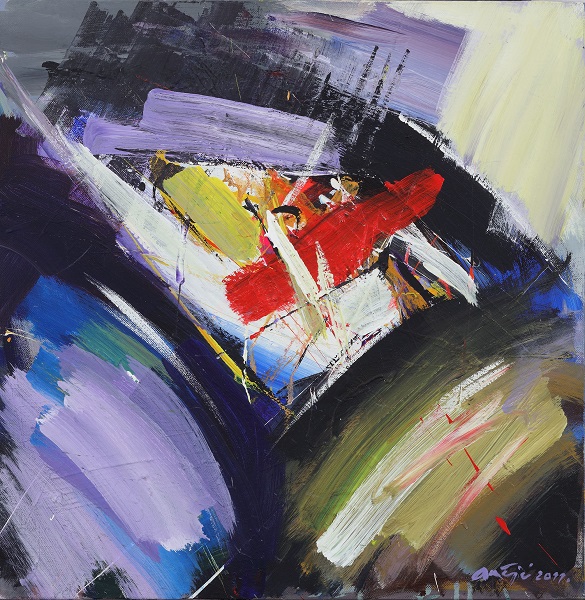
Niko Ančić has always been loyal to color realizing its power, energy, brilliance, and flow in the contact with the World. He understands landscape as a perfection of creation where you cannot add or take away anything. It is also Iike a weft in an artistic eye inwrought within the infinity of spiritual. Beauty is the base of sense inscribed in the idea of landscape. Niko Ančić is not under the pressure of style classification, but we can mention that in the subtle version of more gentle colorism he participates with general rules of impressionistic style and in the passion of artistic art with adequate support of color charged with expressionistic energy. In his opus Ančić has managed to create a significant role in Croatian modern and contemporary painting, rehabilitating landscape art and themes that arise from it with a truly artistic dominance. - Stanko Špoljarić
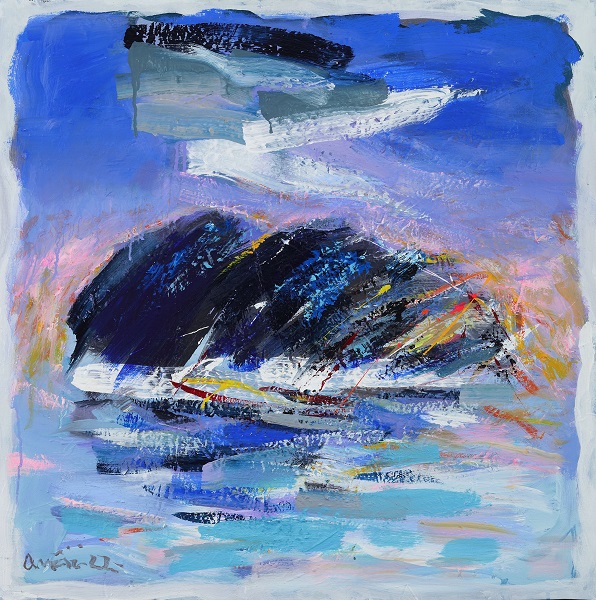
Niko Ančić is a Croatian artist, born in 1948 in Trpanj on the Pelješac peninsula. He is known for his expressive style and vibrant color palettes. Ančić's work often features landscapes and themes inspired by his native region, but also explores abstract and figurative elements.
MARA BRATOŠ _ THE TRUTH
20.7. _ 4.9.2022.
Concept: Mara Bratoš | Petra Golušić
Curator: Petra Golušić
 FROM THE SELF-NUDES INF THE FORES CYCLE, 1995
FROM THE SELF-NUDES INF THE FORES CYCLE, 1995
Contemporary photographer Mara Bratoš has created cycles of nude portraits of herself: ‘Self-Nudes in the Forest‘ (1995), 'Self-Nudes’ (2005), 'Self-Nudes 2015’ (2015), 'Love and Life of a Woman’ (2017), 'Self-Portrait with Daughter’ (2021) and 'Pavla and Mara' (2022). The techniques vary from analogue to digital modes. The body photographed is shown as a whole or in parts, it is posed.
‘The body is known and absolutized.’ (Claude Cahun) Implicit in this point is the author's objectivization of individual content that is adduced in simplified manner.

FROM THE SELF-NUDES CYCLE, 2015
It is possible slowly and profoundly to follow the transformation of the posing of the female figure recorded with the subtle and refined aesthetic, the quality and sharpness of insight in the staged and directed scenes. The physicality seen through the lens placed opposite is the entry into the universe of beings that is presented. Various kinds of being are adduced. What is experienced, known, felt – that is what is presented. Perceiving the subject in self-presentation, it is described within a light that is masterfully recorded. Using the inductive method, the artist considers and registers the body that is being examined at several levels. The interior is revealed in such a way that the individual is staged ontologically. An objective territory is achieved that breaks down all borders of the private in ultimate disclosure.
The relation of body and the outer coordinates is directed with great refinement. The relation of surroundings to motif alters, and vice versa. Spatiality in the work of Mare Bratoš is a forest, a created stage with a floral pattern or is a descriptive background reduced to empty wall. The space in which the photography is done always has a symbolic meaning.
Aesthetic phenomena: the body and fragments of the body are a metaphysical landscape.
The work is steeped in the mystery.
Mental and physical existence are considered. It is possible to see the primordial necessity for self-re-examination, the full experiencing of life irrespective of how much weight or lightness is stored up within it. From girl to woman, mother; various movements are shown without the mask. The body is the utterance of the liberated spirit – of absolute freedom in its endless, unlimited liberation.
In the work of Mara Bratoš the body is - truth.
It is a reflection of pain, suffering, danger, existential insecurity, absence, the urge for self-preservation, the experience of crisis, unrest, trauma, drama, psychosis, the wounds of the world. It is a metaphor for the lived socio-cultural environment and the civilization in which it exists. At the same time, the nude stages authentic liberty, a testimony to mystery, safety, sacred emptiness, peace, harmony, sensuality, sensitivity, Platonic Eros, secret writing, mysticism, the limitlessness of the spirit.
Existential and ontological experiences are always at hand.
A specific subjectivity finds its way to the universal zone. A general art of portraiture is created.
An essential word tells of - the truth, irrespective of what it is like.
Truth is never a supertemporal being, ‘but what crucially affects human existence and makes it responsible’. One arrives at Heidegger’s understanding of art as the putting of truth to work, ascribing to artistic creativity an ontological function since for him that is one of the basic ways in which the sense of the being of being as a whole is revealed.

FROM THE LOVE AND LIFE OF A WOMAN CYCLE, 2017
BIOGRAPHY
Mara Bratoš was born in Dubrovnik in 1974. She went to elementary school in her native city, and to Cherry Hill High School West, Philadelphia, graduating in 1992. In the same year she enrolled in the Film and TV Camera Department at the Academy of Dramatic Art at Zagreb University, graduating in 1998. She worked for a number of magazines (Cosmopolitan, Globus, Elle, Klik) and from 1999 to 2015 was photography editor of the finance and business monthly Banka. From 2006 to 2014 she worked for the Zagreb Youth Theatre as photographer and documentalist; from 2014 she had the same position in the Croatian National Theatre in Zagreb. She won the Best Young Artist Prize (Croatian Photography, 1995, Art Pavilion, Zagreb) and in 1999 the Panel of Judges of Croatian AICA Prize at the Zagreb Design and Applied Art Youth Salon, Croatian Artists’ Centre, Zagreb. She is a member of the artists associations ULUPUH, HZSU, HDFD and HDLU Dubrovnik. Her work has been discussed in print by Leonida Kovač, Sandra Križić Roban, Antun Maračić, Marija Tonković, Slaven Tolj, Goran Trbuljak, Višnja Slavica Gabaut and others. Since 1995, Mara Bratoš has had a continuous record of exhibiting, at many solo and collective shows at home and abroad. She lives and works in Zagreb.

FROM THE PAVLA AND MARA CYCLE, 2022
JOSIP IVANOVIĆ
CARLINGS, 2012 – 2022
Curator: Andrea Batinić Ivanković
Duration: 18.5.2022. – 3.7.2022.

CARLINGS, 2022.
acrylic on canvas
155 x 200 cm
It is in societies with prevailing modern production that life is presented as a huge accumulation of scenes. In that respect, Ivanović’s accumulation of toy car scenes that unify both time and space, become, and already are, a symbol of modern civilisation and the current theme of modern life. The central motif of art by the Dubrovnik-based painter Josip Ivanović is a car as a starting point for defining the modern world module.

CARLINGS, 2014.
combined technique on paper
36 x 92 cm
One of the first features of his handwriting is recognised by the cultivated graphic matrix, revealing an exceptional connoisseur of graphic procedure in the lucid permeation of métier skill and creative invention. By synthesizing matter and the spiritual, Ivanović creates his process on a solid graphic base in inventive mutations he "frames" thematic issues without emphasizing the environmental component, but creates his own discourse of distinctive artistic expressiveness.
(Milan Bešlić)

CARLINGS, 2014.
combined technique on paper
32 x 68 cm
The realistic, visual template of the toy cars in the painter's works sheds its realistic component and becomes one of the undefined, abstract forms that make up the painting. Abstracting objectivity in favour of the autonomy of line, shape, stain, and chromatic accent, Ivanović did not entirely renounce certain reference qualities, because while looking at his paintings, we cannot escape the impression that they are a kind of variation on the artist's understanding of painting.

CARLINGS, 2022.
acrylic on canvas
155 x 200 cm

L'ÉTOILE, 2020.
acrylic on canvas
155 x 200 cm
Non-figural and figural motifs are merged into a whole, as well as sections of evenly applied colour and clean lines. He places the same toy car motifs, which he shapes in different colours in many ways. Their positions are dislocated within the set frame, giving a strong impression of motion, of being in motion, but also the impossibility of culmination. .Ivanović's goal is not only to create pure abstract forms, but forms that motivate.

CARLINGS, 2018.
acrylic on canvas
155 x 200 cm

CARLINGS, 2017.
acrylic on canvas
155 x 200 cm
As he is a sculptor by vocation, for him, sculpture is a sign for syntactic, intra-artistic and abstract organisation of solid static objects. With a clear vision, he develops his embodied thought - through wooden toy car sculptures as well as their 3-D models, the artist speaks culturally coded language. He moves them out of the perspective space of two-dimensionality and introduces them to the third dimension.

CARLINGS, 2016. – 2022.
wood, colour
min 17,5x39,5x10cm – max 22x53,5 x 10cm (7x)
By combining materials, he created sculptural works in which wood and plastic coexist happily, each with its own morphological and artistic preferences - these are works whose forms clearly indicates the desired content and motif association, primarily focused on the world of everyday modern life.

CARLINGS, 2022.
wood, colour
min 17,5 x 39,5 x 10 cm - 22 x 40 x 13,3 cm (x6)
BIOGRAPHY
Josip Ivanović was born in Sarajevo in 1961. He graduated from the Academy of Fine Arts in Sarajevo in 1988, after which he went to Dubrovnik. Through the career spanning more than three decades, he has been working in different fields and media, including sculpture in glass and metal, drawings, collages and graphics, paintings and reliefs, theatre scenography’s and public sculptures and monuments. He fought in the war in Croatia (1991 – 1995) after which he worked alongside French restorers and masons on different restoration projects of stone buildings in the Dubrovnik Old Town. He has had over fifty solo and group exhibitions in about forty cities all over the World and his fruitful oeuvre has been featured in numerous articles, and several radio and TV documentaries. He has been a member of the Croatian Association of Artists since 1988 and the Croatian Freelance Artists Association since 1993. He lives and works in Dubrovnik.
BETWEEN THE REAL AND THE SURREAL
from the MOMAD collection
Curator: Andrea Batinić Ivanković
8.3. – 12.5.2022.
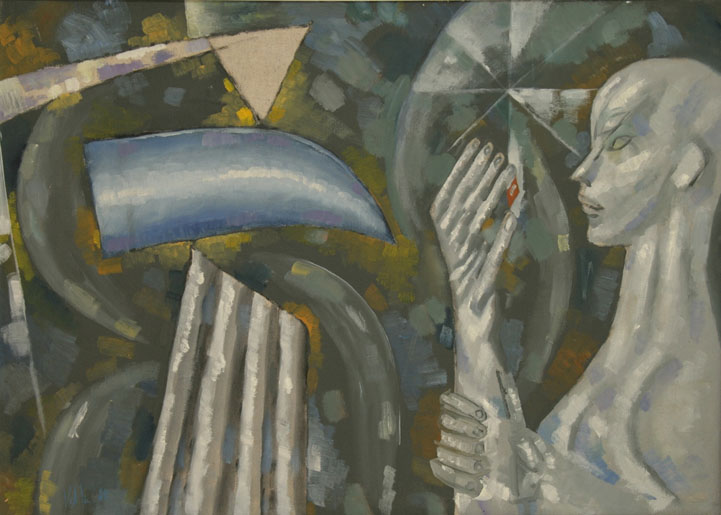
The preoccupation with the human figure and the naked human body has been known since ancient times; during antiquity and the Middle Ages, through the Renaissance and Baroque to the present day, iconography often included a naked or semi-naked body, a human figure in real or imaginary space.
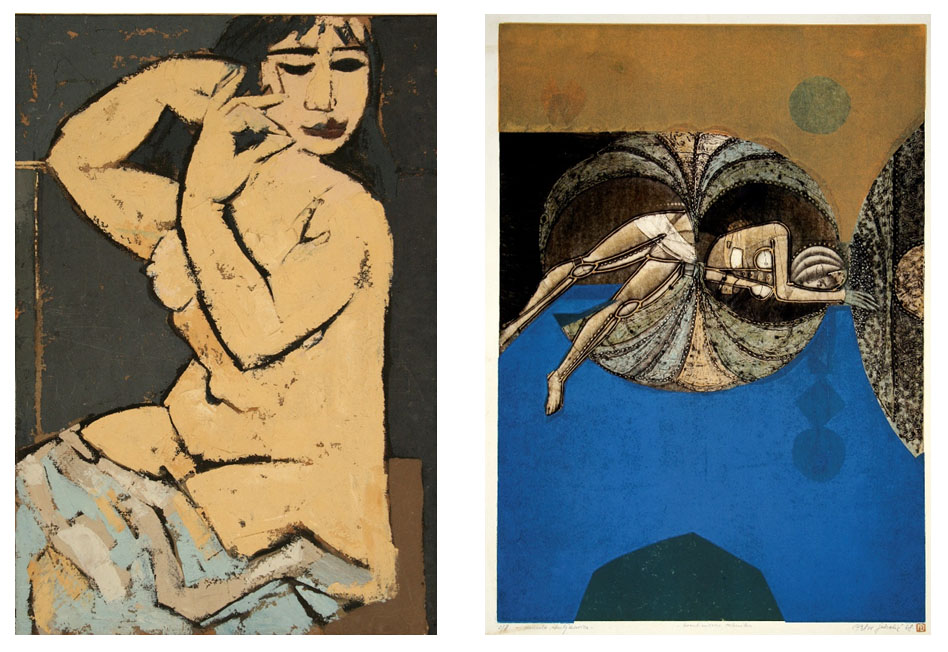
ARTISTS:
BIOGRAFIJE
Dušan Džamonja
Josip Ivanović
Petar Jakelić
Nives Kavurić Kurtović
Vasko Lipovac
Lukša Peko
Milovan Stanić
Pero Šantić
Josip Škerlj
Agnez (Neža) Velikonja
Zlatan Vrkljan
DUBROVNIK COLOURISTS 1918 – 1945
- a Selection from the Collection of MOMAD
21. 12. 2021. – 30. 1. 2022.
Gallery Dulcic Masle Pulitika
Curator: Andrea Batinić
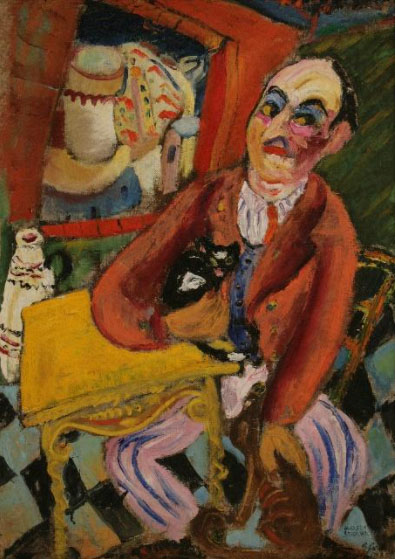
Božidar Rašica, Portret Koste Strajnića, 1935., ulje na platnu, 78 x 57 cm
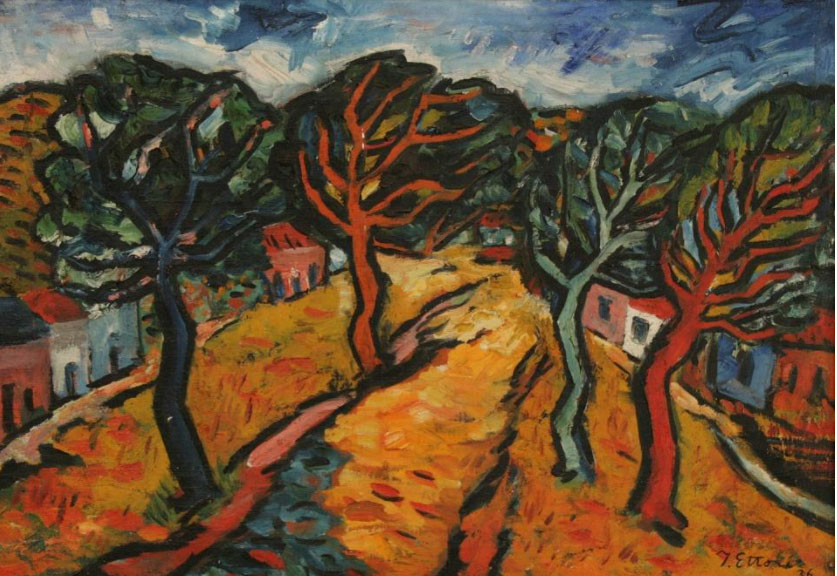
Ivan Ettore, Ulica sa četiri stabla, 1936., ulje na platnu, 48,5 x 66,3 cm
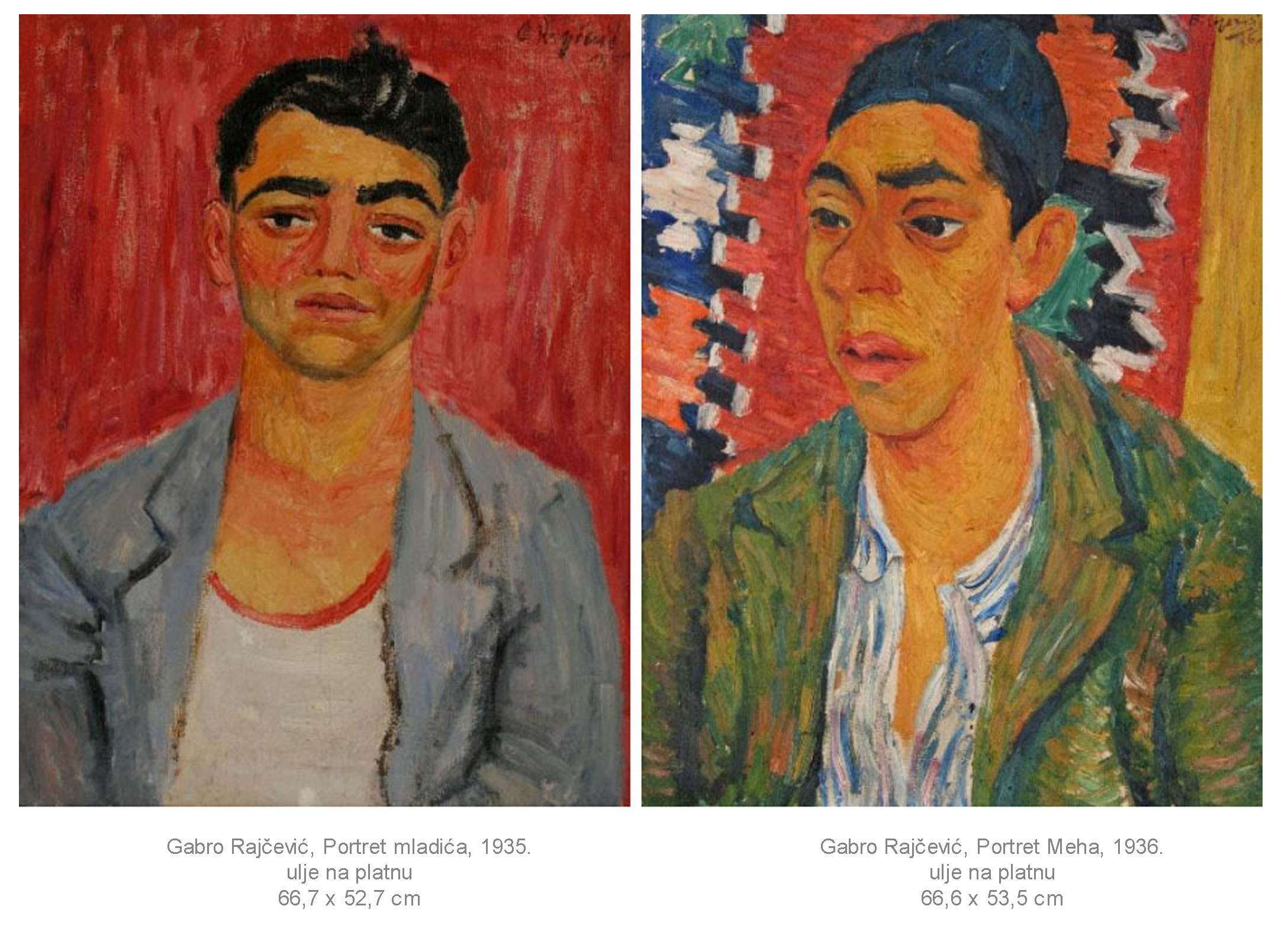
This exhibition not only formulates the specific features and particularities of the South itself, with an emphasis on the painting tendencies and events of the time, but also contains an insight into a specific feature – the Dubrovnik colourist circle –its characteristics and protagonists, and elaborates the basic characteristics of all the artists and their stylistic achievements With a selection of works from the Dubrovnik Museum of Modern Art, an analysis of individual works is conducted that tells of the stylistic productions of artists at work in the period between the two wars, with a careful emphasis on the setting in which they were formed and worked in the area of art and on the reception of individual dominant stylistic patterns of the time in which they lived. Principally there are works in which there is a considerable colourist liberation in cycles of portraits, still lifes and coastal area landscapes. By painting portraits, still lifes and landscapes filled with profoundly personal symbolism, they take us into the area of intimism and the reality of the world in which these artists lived. The Dubrovnik colourists left their mark with their paintings, which take us back to the past, to the feeling of belonging to the City and its artistic circle, while at the same time we move out into spaces of the future, where the trace of the Dubrovnik painting circle can be felt in the contemporary art of our clime.
Artists:
Gabro Rajčević (1912. – 1943.)
Ivan Ettore (1911. – 1938.)
Marko Rašica (1883. – 1963.)
Božidar Rašica (1912. – 1992.)
Niko Miljan (1891. – 1962.)
Ignjat Job (1885. - 1936.)
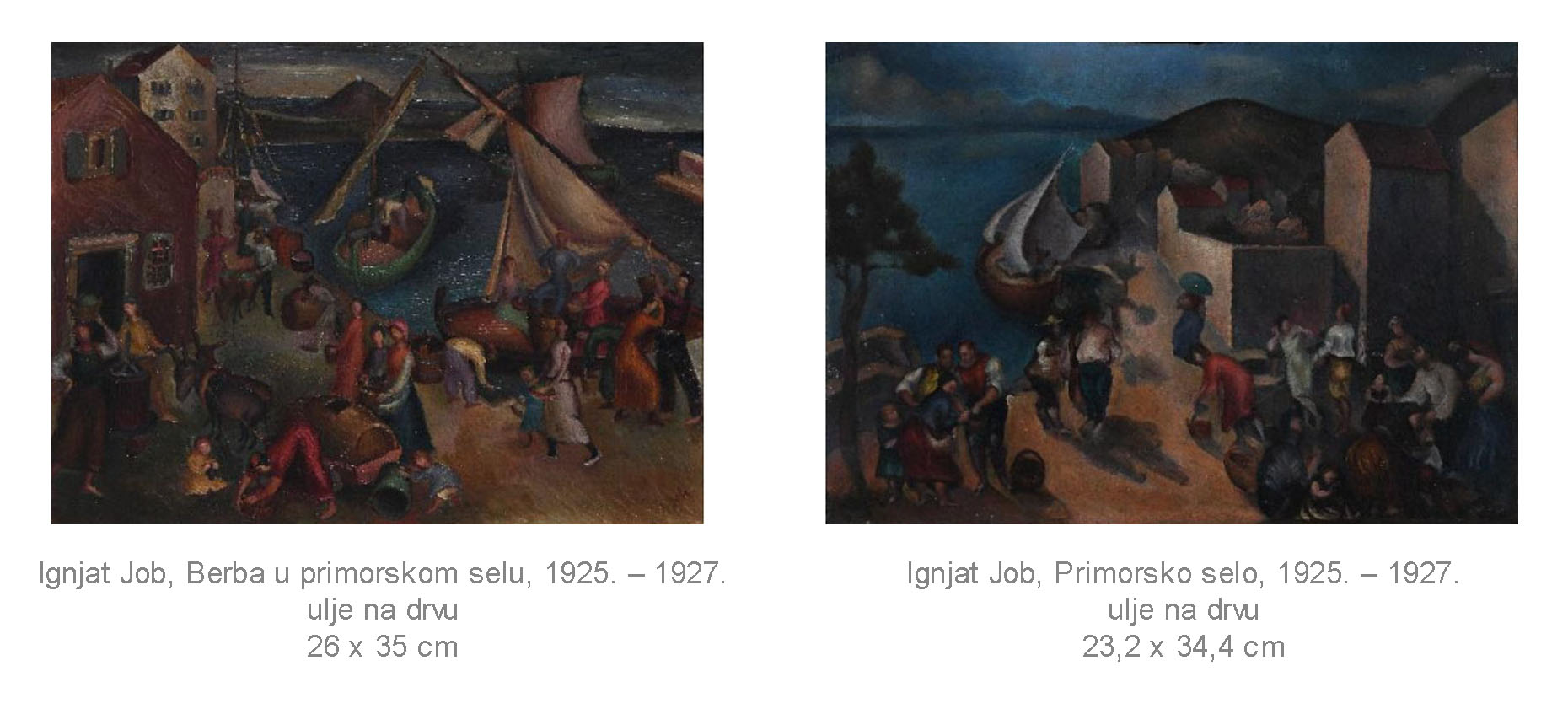
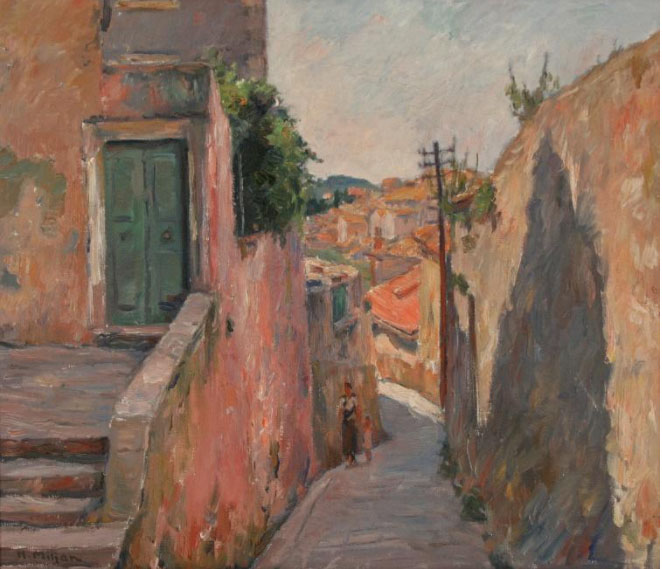
Niko Miljan, Ulica između vrta, oko 1948., ulje na platnu, 63,7 x 73 cm
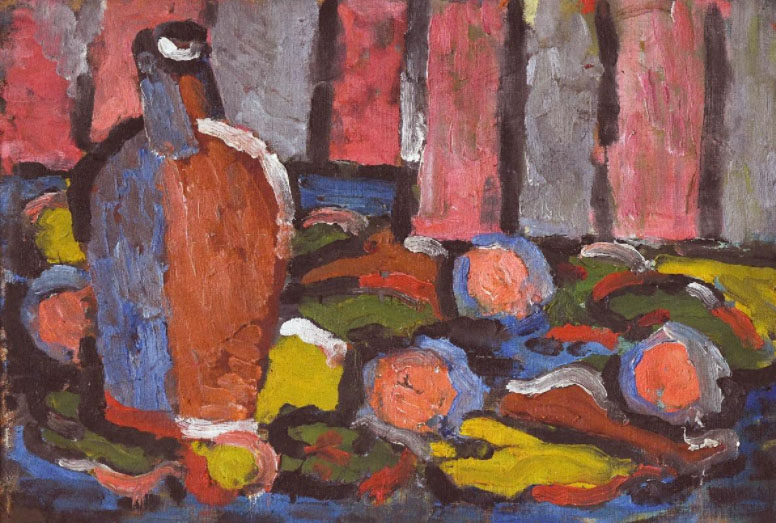
Gabro Rajčević, Mrtva priroda, 1934., ulje na platnu, 50 x 48,1 cm

Marko Rašica, Pejzaž s Lokruma, 1932., ulje na platnu, 55,5 x 68,5 cm
IVANA PEGAN _ SOMEWHERE
4.12.2021. – 30.1.2022.
Curator: Petra Golušić
Multimedia artist Ivana Pegan is represented in this exhibition by books, video works, photographs, photographs with text or typewritten words, pictures that may or may not contain writing. The idiom is built up from the world of life and the world of language the aesthetics of which is founded on the dividing line of the key questions of fundamental areas, biography, fiction and live metaphors. Pegan deals with an analysis of the conditions of the perception of space and objects and its conceptual and linguistic interdependencies. She explores the cognitive and aesthetic effects that are diverse because of the material and metaphysically structural conditions. With theoretical, philosophical and linguistic debates, she opens up specific areas of artistic work, expression and presentation. She considers the self-knowledge of the subject, and cognition. She interprets life, both realistic and imaginary, with a softness of expression of acute perception and presents it in its refractions and in its light.
Books, particularly in the visual code, have the characteristics of zen – spontaneity, simplicity, calmness and loneliness. Photographs and textual contents theoretically problematise the given or the imagined surroundings, language and mental representation. A testimony is created about imagined events and about those that are not. Authentic quotations of individual lives are linked up with codes of public and private communication and with the magic of imagination. The dignity of existence is expressed. A space that is ontologically legible is created.
 |
 |
BOOK # 3, 2018
21 x 15 x 1 cm
detail
In a series of photographic diptychs, which she directs with just a word or two, the author opens up the key issues related to the human being.
 |
 |
ONCE UPON A TIME, 2019
fine art print, typewritten characters – letters
21 x 15 cm (2 x)
The artist during her isolation in the time of the COVID-19 plague in these regions of the world created works in watercolour and gouache. The link of writing|painting the word and the picture field took place. The interpictorial and the intertextual are explored. Text is a narrative framework for the understanding of the image and in general in the work of this artist there is a philosophical relationship established between it and the visual account.
Somewhere is one of the works made up of eight images some of which also have words in them. The first part says if there is and the second no. The possibility is opened up for the existence of the real world while in the next part of the artwork there is direct consideration of the lack of existence of any such thing. After that come three abstract images that signify the limitlessness in the human, and two pieces of writing: we will and meet. The existence of the territory of encounter is announced, territory that is cancelled out as phenomenal world and is not of a material nature. This is a story of human being and the necessity of the human for the destined other. It is about the creation of an area that excludes reality and stands for zones in which spiritual expanses are the only possible place of encounter that are set us from the absolute being|absolute spirit and are necessary for continued existence. /…/ The cycle is represented by a denuded, liberated and empty landscape adduced at various levels as truth and eternal existence. It cannot be done away with or cancelled out even in the hardest|darkest periods of an individual and the world, periods in which it is simply necessary to survive.
 |
 |
SOMEWHERE, 2020
watercolor, gouache, paper
65 x 50 cm (7 x)
detail

UNTITLED, 2020
watercolor, gouache, paper
65 x 50 cm
What is going on in the work of Ivana Pegan? There is an incessant and subtle wish to arrive at the truth about the being of the world and of life, at the pith and marrow of the human being. Clearly stated is the human drive for knowledge of the transcendence, unchangeable and truthful being of everything that exists. Adduced are the dark and the light of being. Presence is analysed. Time is annulled. The perception of life in its ordinariness and quiet magnificence is mapped in simplified terms. With philosophical profundity the interior and the exterior zones which we both create and have assigned to us are connected. The imaginary is opened up. The essence of the freedom of the spirit is marked. The pure place is encoded.
 |
 |
 |
MOOD, 2017
ink, paper
50 x 65 cm (3 x)
BIOGRAPHY
Ivana Pegan was born in 1971 in Doboj. She took her degree in 1996 from the sculpture section of the Academy of Fine Arts of Zagreb University, class of Šime Vulas. In her work the artist explores and starts up various discourses through the means of audio works, video works, artist’s books, diary|books – works, photographs, installations and other things. She is a member of the Croatian Association of Independent Artists, Lazareti Art Workshop in Dubrovnik, the art organisation Tkivo and Dubrovnik Art Forum. She is the manager of the Flora Gallery of the Croatian Association of Fine Artists Dubrovnik and also works with restoration. She has exhibited at many solo and collective exhibitions and other events at home and abroad. She lives and works in Dubrovnik.



